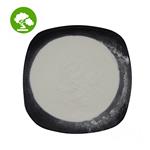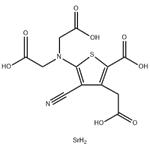- Strontium ranelate
-

- $0.00/ KG
-
2024-04-12
- CAS:135459-87-9
- Min. Order: 1KG
- Purity: 99%
- Supply Ability: 20000kg/Month
- Strontium ranelate
-

- $0.00 / 1kg
-
2023-11-01
- CAS:135459-87-9
- Min. Order: 1kg
- Purity: 99.0% min
- Supply Ability: 1000kgs/month
|
| | Strontium ranelate Chemical Properties |
| Melting point | >310°C (dec.) | | storage temp. | Inert atmosphere,Store in freezer, under -20°C | | solubility | H2O: soluble1mg/mL, clear (warmed) | | form | powder | | color | white to beige | | CAS DataBase Reference | 135459-87-9 |
| Hazard Codes | Xn | | Risk Statements | 20/21/22 | | Safety Statements | 36/37 | | RIDADR | 3077 | | WGK Germany | 3 | | RTECS | XM7581000 | | HS Code | 29349990 |
| | Strontium ranelate Usage And Synthesis |
| Drug for the treatment of osteoporosis | Strontium ranelate is a drug for the treatment of osteoporosis with its appearance being white to light yellow powder or crystalline powder. It is odorless and slightly soluble in water but almost insoluble in ethanol and easily soluble in dilute hydrochloric acid. It was first studied and developed by the French Servier Company and had first entered into market in November 2004 in Ireland and entered into market in UK in December of same year. Japan's Fujisawa Pharmaceutical Company has owned the authorization of development, production and marketing right of this product in Japan. It is clinically mainly used for the treatment and prevention of osteoporosis in postmenopausal women with significantly reducing the risk of occurrence of vertebral fractures and hip fractures.
Strontium ranelate has dual pharmacological inhibitory effects of both inhibiting bone absorption and promoting bone formation. On the one hand, in the osteoblast-enriched cells, it can increase the synthesis of collagen and non-collagen proteins and promote the osteoblast-mediated bone formation mediated by osteoblasts through enhancing the proliferation of pre-osteoblast. On the other hand, through decreasing the osteoclast differentiation and reabsorbing activity and further reduction of bone absorption, it achieves the rebalance of bone turnover, further boosting the bone formation.
Strontium ranelate mainly exerts its pharmacological effects through its strontium atoms. Strontium is an alkaline earth metal element which is cognate with calcium and located under the calcium in the element periodic table. Its absorption, distribution, excretion is similar with calcium. After oral administration of 2g, the absolute bioavailability of strontium is 27%. Large doses of strontium cause abnormalities of bone mineral metabolism with low doses of strontium being able to the enhance the pre-osteoblast replication, increasing the number of osteoblasts to stimulate bone formation while reducing the activity of osteoclasts, reducing osteoclast quantity as well as reducing the rate of bone absorption. The results are consistent with the results found in animal and human in vivo studies.
s (OP) is a progressive skeletal disease, characterized by reduced bone mineral density (BMD) and degenerative changes in bone tissue microstructure. It is exhibited as bone fragility and fracture-prone with the latter most commonly happening in the spine, hip and wrist. For women, when after surgical removal of the ovaries or menopause, the body stops producing bone to maintain strong estrogen, thus, primary OP is particularly common in post-menopausal or menopausal women.
There are currently two major kinds of drugs used in the treatment of osteoporosis: one kind includes those drugs that inhibits osteoclast activity and therefore inhibiting bone absorption such as bisphosphonates, estrogen and calcitonin; the second category includes those drugs which promote the osteoblast activity, and thereby stimulating bone formation and there are currently only a product, human recombinant parathyroid hormone 1-34, that has entered into market. It however requires injection with high drug prices.
The above information is edited by the chemicalbook of Dai Xiongfeng.
| | Uses | It is mainly used for the treatment and prevention of osteoporosis in postmenopausal women and significantly reduces the risk of occurrence of vertebral fractures and hip fractures.
| | Description | Strontium ranelate, a divalent strontium salt of ranelic acid, has been developed
and launched for the treatment of osteoporosis. As early as 1910, investigations
suggested that strontium stimulates the formation of osteoid tissues while simultaneously
repressing the resorptive process in bones. Specifically, strontium enhances
pre-osteoblastic cell replication, inhibits pre-osteoclast differentiation, and
suppresses the bone-resorbng activity of osteoclasts. From the evaluation of 26
strontium salts, ranelic acid was selected as the ideal strontium carrier due to its
physicochemical and pharmacokinetic properties. The thiophene core of ranelic
acid is constructed by the condensation of dialkyl 3-oxoglutarate, malononitrile,
and sulfur in a suitable alcohol in the presence of morpholine or diethylamine. The
resultant diester of 5-amino-3-carboxymethyl-4-cyano-2-thiophenecarboxylic acid
is subsequently dialkylated with an alkyl bromoacetate to provide the tetraester
precursor to strontium ranelate. Strontium ranelate is supplied in a 2 g sachet, and
the drug is evenly suspended in water prior to consumption. Since the simultaneous
ingestion of either calcium or food has a negative influence on the bioavailability of
strontium ranelate, it is recommended that strontium ranelate be administered once
a day at bedtime. Following this regimen, the absolute bioavailability of strontium
is 27% while that of ranelic acid is 2.5%. Because strontium ranelate dissociates
after intake, and ranelic acid has negligible absorption, the effects of the drug on bone metabolism are dependent on the pharmacokinetics of strontium. In postmenopausal
women, the half-life of strontium is 6.3±2.3 days, and renal clearance
accounts for 57%of the total clearance of 12mL/min. After a 25-day treatment, the
maximum plasma concentration of strontium is 20±2.3 mg/L. In addition, not only
is perfect stability of strontium plasma concentration achieved within 3 to 24
months of chronic administration so is stabilization of strontium incorporation into
bones. Strontium is incorporated into bone by two mechanisms. The predominant
mode involves the rapid, saturable surface exchange with calcium. A slower mechanism
embodies the incorporation of strontium into the crystal lattice of the bone
mineral; however, only a small amount of calcium in the apatite is substituted by
strontium at pharmacological doses. A phase II clinical trial assessed the effect of
various strontium ranelate doses in postmenopausal women with established osteoporosis.
The primary efficacy endpoint for this double-blind, randomized, placebo-
controlled trial was the measure of mean lumbar bone mineral density (BMD)
by dual-energy X-ray absorptiometry. A statistically significant dose-dependent
increase in lumbar BMD was observed; increases of 1.3, 5.9, 8.3, and 13.6%
were recorded for placebo, 500-, 1000-, and 2000-mg doses of strontium ranelate,
respectively. In a phase III trial encompassing 1,649 osteoporotic postmenopausal
women from 12 countries, the efficacy of a 2 g/day dose in preventing new vertebral
fractures was evaluated. The mean lumbar BMD was 0.73 g/cm2 while the mean
age at baseline was 70 years. All of the enrolled patients had at least one prior
vertebral fracture. The primary end point for this study was a reduction in
the incidence of patients experiencing fractures. While 222 women in the placebo
group experienced a new vertebral fracture, only 139 patients treated with strontium
ranelate presented with new fractures. Furthermore, the risk of fracture was
reduced by 51% in the third year alone, implicating the sustained efficacy of
the drug. For both the phase II and phase III studies, strontium ranelate was well
tolerated with most of the adverse events being mild-to-moderate in severity. The
most commonly reported events in all treatment groups were musculoskeletal disorders
(back pain, arthralgia, and lumbar pain). As for laboratory measurements,
only creatine phosphokinase, the musculoskeletal isoenzyme, was significantly elevated
in the 1000-mg and 2000-mg strontium ranelate groups; however, this did
not translate into any particular clinical or biological abnormality. Without
relevant data regarding bone safety in patients with renal impairment, strontium
ranelate is currently contraindicated in patients with creatine clearance below
30mL/min. | | Chemical Properties | Crystalline Solid | | Originator | Fujisawa (Japan) | | Uses | Strontium ranelate (Protelos) is a strontium(II) salt of ranelic acid for (-)-desmethoxyverapamil binding to calcium channel with IC50 of 0.5 mM. | | Uses | Bone metabolism modulator; inhibits bone resorption while maintaining bone formation. Antiosteoporotic. | | Brand name | Protelos | | Clinical Use | Treatment of post menopausal osteoporosis and men at
high risk of fractures | | Drug interactions | Potentially hazardous interactions with other drugs
Calcium-containing compounds: separate
administration by at least 2 hours.
Antacids: separate administration by at least 2 hours.
Antibiotics: strontium can reduce absorption of oral
tetracycline and quinolones - suspend strontium
therapy during treatment. | | Metabolism | Strontium ranelate has a high affinity for bone tissue. It is
not metabolised, and excretion occurs via the kidneys and
gastrointestinal tract. |
| | Strontium ranelate Preparation Products And Raw materials |
|